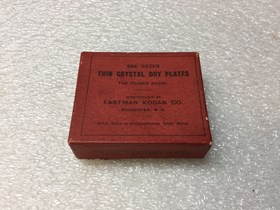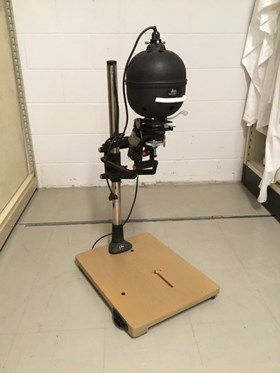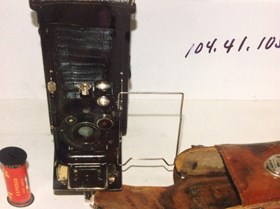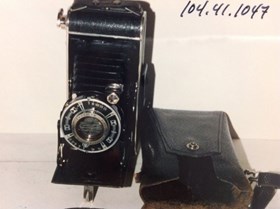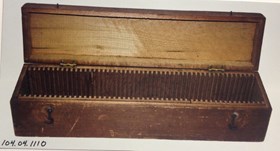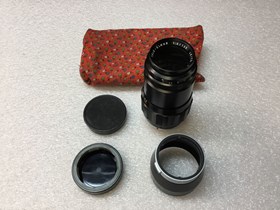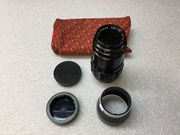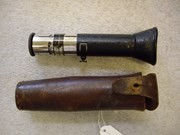Narrow Results By
Disposable Camera
https://archives.whyte.org/en/permalink/artifact104.41.1066
- Date
- prior to 1989
- Material
- synthetic, plastic; paper
- Catalogue Number
- 104.41.1066
- Description
- A Fujicolor Quicksnap Flash disposable camera. A black plastic camera in a green, white, black and gold box. It has instructions for taking the photographs on the back. Battery and film removed for processing. Made in Japan.
1 image
- Title
- Disposable Camera
- Date
- prior to 1989
- Material
- synthetic, plastic; paper
- Dimensions
- 12.7 x 5.7 cm
- Description
- A Fujicolor Quicksnap Flash disposable camera. A black plastic camera in a green, white, black and gold box. It has instructions for taking the photographs on the back. Battery and film removed for processing. Made in Japan.
- Subject
- photography
- Credit
- Gift of Phyllis H. Horpenuk, Banff, 1989
- Catalogue Number
- 104.41.1066
Images
This material is presented as originally created; it may contain outdated cultural descriptions and
potentially offensive content.
Read more.
- Date
- 1920 – 1940
- Material
- cardboard; paper; glass;
- Catalogue Number
- 104.41.0220
- Description
- Box of one dozen Thin Crystal Dry Plates for a Pocket Kodak camera. The box’s seal has been broken - inside are alternating layers of thin black paper and the glass plates, which are fogged.Dry plate, or the gelatin process, was invented by Dr. Richard L. Maddox in 1871 and replaced the more time-c…
1 image
- Title
- Dry Plates
- Date
- 1920 – 1940
- Material
- cardboard; paper; glass;
- Dimensions
- 1.9 x 6.0 x 5.1 cm
- Description
- Box of one dozen Thin Crystal Dry Plates for a Pocket Kodak camera. The box’s seal has been broken - inside are alternating layers of thin black paper and the glass plates, which are fogged.Dry plate, or the gelatin process, was invented by Dr. Richard L. Maddox in 1871 and replaced the more time-consuming wet plate, or collodion process, which required active wet chemicals to be prepared in mobile dark rooms. The dry plate process underwent several adaptations throughout the 1870s and, in 1879, George Eastman developed a method of applying the emulsion layer to glass in a factory setting, simultaneously creating what came to be known as the Eastman Kodak Co. and bringing down the cost of photography so as to be accessible to the masses.
- Subject
- photography
- photographic equipment
- Credit
- Gift of Catharine Robb Whyte, O. C., Banff, 1979
- Catalogue Number
- 104.41.0220
Images
This material is presented as originally created; it may contain outdated cultural descriptions and
potentially offensive content.
Read more.
- Date
- 1920 – 1945
- Material
- wood; metal; glass; plastic;
- Catalogue Number
- 104.41.0170
- Description
- Black and silver metal Leitz negative enlarger mounted on a wooden base. The enlarger consists of an almost round light housing with the power cord coming out from the top - immediately below the globe is a series of plates containing the various filters and lenses, as well as the mounting gear tha…
1 image
- Title
- Enlarger
- Date
- 1920 – 1945
- Material
- wood; metal; glass; plastic;
- Dimensions
- 95.8 x 41.7 x 51.9 cm
- Description
- Black and silver metal Leitz negative enlarger mounted on a wooden base. The enlarger consists of an almost round light housing with the power cord coming out from the top - immediately below the globe is a series of plates containing the various filters and lenses, as well as the mounting gear that attaches the enlarger to the silver metal stand. The enlarger is attached to the stand with adjustable arms and a spring that can be released with a small lever so that the device can be moved closer to or further away from the wooden base.
- Credit
- Gift of Nicholas Morant, Banff, 2006
- Catalogue Number
- 104.41.0170
Images
This material is presented as originally created; it may contain outdated cultural descriptions and
potentially offensive content.
Read more.
- Date
- 1960 – 1980
- Material
- metal; plastic; paper; glass;
- Catalogue Number
- 104.41.0119 a-g
- Description
- Rectangular shiny silver metal box with a lift-off lid. Contents of the box include two glass vignettes with edges wrapped in pale brown binding tape [one has a small tab on one side], a yellow-tinted “KODAK SERIES VI ADAPTER RING” mounted in metal, a circular black plastic “CRAFTMEN’S GUILD PICTOR…
1 image
- Title
- Equipment Box
- Date
- 1960 – 1980
- Material
- metal; plastic; paper; glass;
- Dimensions
- 5.1 x 11.7 x 21.0 cm
- Description
- Rectangular shiny silver metal box with a lift-off lid. Contents of the box include two glass vignettes with edges wrapped in pale brown binding tape [one has a small tab on one side], a yellow-tinted “KODAK SERIES VI ADAPTER RING” mounted in metal, a circular black plastic “CRAFTMEN’S GUILD PICTORAL CONTROL” fixture with a clear central hole, a thin grey cardboard Kodak box with a strip of paper adhesive tape wrapped around the box holding the lid closed that has “2 1/4 x 3 1/4 Glasses for A - Assembly Enlarger” in blue ink [most likely written by Morant], a second thin Kodak cardboard box with a paper adhesive tape on the lid that has “MASKS for PRECISION A” written in black ink [probably by Morant] that contains wax paper envelopes of coloured celluloid masks, and a paper Canadian Pacific Railway envelope that contains wax paper envelopes of coloured celluloid masks.
- Credit
- Gift of Nicholas Morant, Banff, 2006
- Catalogue Number
- 104.41.0119 a-g
Images
This material is presented as originally created; it may contain outdated cultural descriptions and
potentially offensive content.
Read more.
- Date
- 1960 – 1980
- Material
- wood; plastic; metal; fabric; paper;
- Catalogue Number
- 104.41.0151 a-k
- Description
- Black hard-sided travel case with corner brackets and reinforcing along all edges - hinged lid held closed with three metal clasps. Below the clasps on the front of the case is a wooden handle, from which hangs a wooden travel tag with Nicholas Morant’s address printed in red ink. Throughout the ex…
1 image
- Title
- Equipment Case
- Date
- 1960 – 1980
- Material
- wood; plastic; metal; fabric; paper;
- Dimensions
- 28.6 x 57.2 x 38.5 cm
- Description
- Black hard-sided travel case with corner brackets and reinforcing along all edges - hinged lid held closed with three metal clasps. Below the clasps on the front of the case is a wooden handle, from which hangs a wooden travel tag with Nicholas Morant’s address printed in red ink. Throughout the exterior of the case are various travel stickers and labels, mostly faded and/or torn. The interior of the case is lined with patterned blue and white paper.Contents of the case include:B : two silver metal brackets most likely used to hold/mount a camera flash or light on a tripod - each housed in its own purple fabric bag with “Seagram’s” embroidered on them. Both brackets have small rectangular paper adhesives attached to them - one has “460” written in black ink and the other has “370” written in black ink. C : three metal clamps of various sizes - one housed in a red fabric bag.D : a tripod chain with three open hooks housed inside a metal Kodak developer can with a plastic lid - on the lid is a paper adhesive with “TRIPOD CHAIN” written in black ink.E : three power cords of various lengths - one has a paper adhesive tag that reads “GRAFLEX FLASH” in black ink.F : a flash handle and two alternative parts - all three are made from silver metal and have various plugs and black plastic pieces. G : coiled cables in a black and yellow cardboard box - on the lid is a paper adhesive label with “CABLES” written in black ink - “PHOTOEYE” is also written on the sides of the lid in black ink. H : coiled cables in a white and grey cardboard box - on side of the lid is a paper adhesive label with “TRIPPER” written in black in - “TRIPPER” is also written directly on the lid of the box in black.I : ballheads and screw boards in a beige cardboard box with two paper adhesive labels on the lid - one reads “BALLHEADS 1/4 SCREW BOARD” and the other has Nicholas Morant’s address.J : a handheld chalkboard sign with “MORANT” painted in yellow at the top - the remainder of the board is divided in two, the top section has “P” in the top left corner and the bottom section has “M” in the top left corner. K : handheld digital flash and accessories in a fitted Styrofoam box - taped to the outside of the lid is a “Braun 2000 VarioComputer” instruction manual in a plastic sleeve.
- Credit
- Gift of Nicholas Morant, Banff, 2006
- Catalogue Number
- 104.41.0151 a-k
Images
This material is presented as originally created; it may contain outdated cultural descriptions and
potentially offensive content.
Read more.
Film Magazine Case
https://archives.whyte.org/en/permalink/artifact104.41.0085
- Date
- 1920 – 1940
- Material
- leather; fabric; metal; paper
- Catalogue Number
- 104.41.0085
- Description
- Black hard-sided leather case with a hinged lid that clasps shut with two metal clasps on either side of a metal hinge lock and metal corner braces. There are two metal bases attached to the lid where a handle may have been attached, handle missing. Faded leather strap is attached with metal clasps…
1 image
- Title
- Film Magazine Case
- Date
- 1920 – 1940
- Material
- leather; fabric; metal; paper
- Dimensions
- 27.7 x 34.1 cm
- Description
- Black hard-sided leather case with a hinged lid that clasps shut with two metal clasps on either side of a metal hinge lock and metal corner braces. There are two metal bases attached to the lid where a handle may have been attached, handle missing. Faded leather strap is attached with metal clasps to rings mounted on both short sides of the case. There is a small square sticker, possibly a travel marker from Mexico, on the left-hand short side under the clasp. In the middle of the lid is a rectangular Canadian Pacific label that has “Film Case” written in black ink and a stamped “PROPERTY OF NICHOLAS MORANT BANFF, ALBERTA” in blue ink. Attached with a short piece of white string to the right-hand carry strap clasp is a paper Canadian Pacific tag that has something written in black ink that is badly damaged by water. A cataloguer tag is also attached to that clasp with “MORANT COLLECTION (film magazines)” written on it in black ink.The interior of the box is lined with a dark red fabric, possibly velvet and is divided into two compartments, the left one slightly larger than the right. The interior of the lid is also divided into two compartments that close off with snaps - small leather pull tabs allowed the compartments to be accessed. There are no manufacturer’s marks on the case. Found inside are three different film magazines.
- Credit
- Gift of Nicholas Morant, Banff, 2006
- Catalogue Number
- 104.41.0085
Images
This material is presented as originally created; it may contain outdated cultural descriptions and
potentially offensive content.
Read more.
- Date
- 1920 – 1940
- Material
- metal; leather; plastic; celluloid
- Catalogue Number
- 104.41.0086 a-c
- Description
- Three black metal and leather “GRAFLEX CUT FILM MAGAZINE,” used to store individual celluloid negatives mounted into individual sleeves housed inside the main body. Access to the main body is possible by removing the the thin back panel with a leather strap that slides up alongside the leather bag …
1 image
- Title
- Film Magazines
- Date
- 1920 – 1940
- Material
- metal; leather; plastic; celluloid
- Dimensions
- 11.0 x 3.5 x 6.5 cm
- Description
- Three black metal and leather “GRAFLEX CUT FILM MAGAZINE,” used to store individual celluloid negatives mounted into individual sleeves housed inside the main body. Access to the main body is possible by removing the the thin back panel with a leather strap that slides up alongside the leather bag as well by pressing a button on the edge opposite the leather bag, allowing the front panel to pop open. On the front panel that can pop off is a small peephole accessible by a spring-hinged cover. Two of the magazines, marked with a red and a white strip of fabric, have the front panels taped closed with a small piece of masking tape.The three magazines are meant for different kinds of film. The one marked with a small strip of green fabric is meant for “KODAK EXTACOLOR Professional Type S (Short Exposure),” the one marked with the red fabric is meant for “KODAK EKTACHROME Film 6116, Type B (Process E-3),” and the one marked with the white fabric is meant for “KODAK TRI-X PAN SHEET FILM (ESTAR Thick Base).” The individual slides housed inside the magazine with the green fabric may have unprocessed fogged negatives still in them.
- Subject
- Nicholas Morant
- photography
- Kodak
- film photography
- photo developing
- Canadian Pacific Railway
- Credit
- Gift of Nicholas Morant, Banff, 2006
- Catalogue Number
- 104.41.0086 a-c
Images
This material is presented as originally created; it may contain outdated cultural descriptions and
potentially offensive content.
Read more.
Film Strip Projector
https://archives.whyte.org/en/permalink/artifact105.05.1015
- Date
- c. 1930
- Material
- metal; paper; glass
- Catalogue Number
- 105.05.1015
- Description
- 35 mm film strip projector and case. Simple design projector having rectangular metal base with manufacturer's nameplate. Tower one side of rectangle, housing a bulb. Chrome assembly attached to front of tower concealing first lens, second lens is detachable, rolled in handkerchief. Cylindrical sec…
1 image
- Title
- Film Strip Projector
- Date
- c. 1930
- Material
- metal; paper; glass
- Dimensions
- 21.8 x 15.3 x 21.3 cm
- Description
- 35 mm film strip projector and case. Simple design projector having rectangular metal base with manufacturer's nameplate. Tower one side of rectangle, housing a bulb. Chrome assembly attached to front of tower concealing first lens, second lens is detachable, rolled in handkerchief. Cylindrical section for the insertion of lens, curled flat chrome piece for holding filmstrip, gearing with knob, for advancing strip to next frame. Maroon electric cord coming from back. Black box made of cardboard with red felt inside. Bucket on front for locking. Leather carrying handle. Small box of slide labels marked "Ingram & Bell Ltd.".
- Subject
- photography
- Hubert Green
- Credit
- Gift of Hubert E. Green Jr., Banff, 1986
- Catalogue Number
- 105.05.1015
Images
This material is presented as originally created; it may contain outdated cultural descriptions and
potentially offensive content.
Read more.
- Date
- 1960 – 1979
- Material
- paper; plastic
- Catalogue Number
- 104.41.0108
- Description
- 31 individual Moiré filters in wax paper envelopes with instruction manuals in a repurposed Ansco Photographic Paper box. Filters are in various patterns and shapes and are coloured either black, pink, yellow, or teal.Moiré filters were used in developing photographs to create textured blocks of co…
1 image
- Title
- Filters
- Date
- 1960 – 1979
- Material
- paper; plastic
- Dimensions
- 2.1 x 21.3 x 26.2 cm
- Description
- 31 individual Moiré filters in wax paper envelopes with instruction manuals in a repurposed Ansco Photographic Paper box. Filters are in various patterns and shapes and are coloured either black, pink, yellow, or teal.Moiré filters were used in developing photographs to create textured blocks of colour in order to enhance printed images, usually in advertisement. Moiré patterns are made by overlapping fine-line patterns (such as pinstripes) that are offset from each other at a slight angle - these patterns will appear and disappear depending on the resolution they appear in.
- Credit
- Gift of Nicholas Morant, Banff, 2006
- Catalogue Number
- 104.41.0108
Images
This material is presented as originally created; it may contain outdated cultural descriptions and
potentially offensive content.
Read more.
- Date
- 1969 – 1973
- Material
- plastic; metal; foam; faux leather
- Catalogue Number
- 104.41.1279 a,b
- Description
- a) Sixtron electronic flash meter; body made of two plastic parts in different tones of gray; compact size: 10.4 x 7.0 x 5.4 cm; a spherical diffuser sits at the top in the form of a white plastic protruding half sphere; on the viewer right hand side is the rocker switch to activate battery test an…
1 image
- Title
- Flash Meter
- Date
- 1969 – 1973
- Material
- plastic; metal; foam; faux leather
- Dimensions
- 10.8 x 15.3 cm
- Description
- a) Sixtron electronic flash meter; body made of two plastic parts in different tones of gray; compact size: 10.4 x 7.0 x 5.4 cm; a spherical diffuser sits at the top in the form of a white plastic protruding half sphere; on the viewer right hand side is the rocker switch to activate battery test and flash measurement; on the front, the meter needle scale sits on top of the film speed disk; in the centre of the black disk, it is written in silver lettering: “SIXTRON electronic / GOSSEN”; on the disk, one can also read DIN and ASA exposure index values; at the bottom of the meter, there are two eyelets to attach a neckstrap (missing) and a knurled ring for electric zero adjustment; on the back, there is a screw for mechanical zero, a tripod socket, and a second screw to open the battery chamber above which is written in relief: “Batt. 10 F 15”; at the top of the back, it is written in relief: “GERMANY (WEST )/ CO11471”b) the case is a black faux leather covered prism with a silver lock (key missing) fitted inside with foam padding cut to the shape of the meter
- Subject
- Nicholas Morant
- photography
- Credit
- Gift of Nicholas Morant, Banff, 2006
- Catalogue Number
- 104.41.1279 a,b
Images
This material is presented as originally created; it may contain outdated cultural descriptions and
potentially offensive content.
Read more.
- Date
- 1920 – 1930
- Material
- metal, leather, glass
- Catalogue Number
- 104.41.1052 a-d
- Description
- Folding camera (a) with case (b); bellows-lens assembly rides on foldout bed; lens plate (c) holds lens;viewfinder top left corner; has "Compur" below lens; wire rectangle unfolds left; knob top right moves lens plate up and down; bed has distance indicator;F. PL. select lever; tripod underside of …
1 image
- Title
- Folding Camera
- Date
- 1920 – 1930
- Material
- metal, leather, glass
- Dimensions
- 21.2 x 5.6 x 12.0 cm
- Description
- Folding camera (a) with case (b); bellows-lens assembly rides on foldout bed; lens plate (c) holds lens;viewfinder top left corner; has "Compur" below lens; wire rectangle unfolds left; knob top right moves lens plate up and down; bed has distance indicator;F. PL. select lever; tripod underside of bed, also collapsible rest; leather bellows; leather covered metal body; carrying strap top end; also back release; film advance right top end; compartment attached to camera back which holds cartridge for plates, detachable; flip-up viewing sight to be coupled with wire rectangle; brown leather case "Kodak" in fancy letters on buckle; roll film in camera (d) (Kodak verichrome pan); name/address inside flap.
- Subject
- photography
- Credit
- Gift of Robert N. Smith, Canmore, 1985
- Catalogue Number
- 104.41.1052 a-d
Images
This material is presented as originally created; it may contain outdated cultural descriptions and
potentially offensive content.
Read more.
Folding Camera
https://archives.whyte.org/en/permalink/artifact104.41.1047
- Date
- 1920 – 1940
- Material
- metal, leather, glass
- Catalogue Number
- 104.41.1047
- Description
- Folding camera with case; one side has film advance knob other side has pop up viewfinder (non-optical); leather handle on top portion; lens and bellows assembly unfolds with bed; optical viewfinder beside lens; shutter release, shutter speed selection; aperture selection around lens; first lens el…
1 image
- Title
- Folding Camera
- Date
- 1920 – 1940
- Material
- metal, leather, glass
- Dimensions
- 16.6 x 9.3 x 3.3 cm
- Description
- Folding camera with case; one side has film advance knob other side has pop up viewfinder (non-optical); leather handle on top portion; lens and bellows assembly unfolds with bed; optical viewfinder beside lens; shutter release, shutter speed selection; aperture selection around lens; first lens element unscrews; red window on back; tripod mounts on one side and bottom side of bed; brown leather case with cloth strap.
- Subject
- photography
- Credit
- Gift of Robert N. Smith, Canmore, 1985
- Catalogue Number
- 104.41.1047
Images
This material is presented as originally created; it may contain outdated cultural descriptions and
potentially offensive content.
Read more.
- Date
- ca. 1926 – 1932
- Material
- metal; glass; leather; plastic
- Catalogue Number
- 104.41.0255 a,b
- Description
- A No.1A Pocket Kodak with camera case. a) Black camera with embellished details in the outer covering. On the top, there is a leather handle which reads “KODAK” and is attached to the camera with metal hinges. At the back of the camera is a red glass window. There is also a small opening with a tab…
1 image
- Title
- Folding Camera
- Date
- ca. 1926 – 1932
- Material
- metal; glass; leather; plastic
- Dimensions
- 20.9 x 8.7 x 3.7 cm
- Description
- A No.1A Pocket Kodak with camera case. a) Black camera with embellished details in the outer covering. On the top, there is a leather handle which reads “KODAK” and is attached to the camera with metal hinges. At the back of the camera is a red glass window. There is also a small opening with a tab that can slide open; this is an autographic window which would have allowed the photographer to add handwritten notes into the film negative with a stylus, which would have been included with the camera. There is a tab at the top of the camera that would be used for winding the film. On the back of the camera is an embellished logo reading “USE KODAK FILM No. A116” in a circular motif. The sides of the camera are rounded. On the front is a panel that opens by releasing the latch just above the panel. The front panel has a small hole in it with threads, suggesting that something could be screwed into it like a tripod. There is also a tripod hole on the bottom of the camera. On the outside of the front panel is a metal label with the text: “Kodak” written in embellished script. This label is a metal tab that folds out and operates as a stand for the camera to sit upright. On the back of the kickstand is engraved with the number “132743”. When opened, the inside of the panel door has a metal track. There is also metal hardware such as a screw mechanism that can be spun to move the metal track forward to adjust the viewing distance. On the right is a metal gauge with various distances in feet and meters. When the track is adjusted, a notch in the side of it lines up with the lines on the gauge. The panel door is attached with an elaborate brace that locks to keep the door in an open position. There is a metal knob that can be pulled forward to extend the lens and unfold the lens hood. The lens is connected with a metal frame. There are decorative labels attached to the lens frame. Above the lens is a label that reads: “KODEX” and has a logo reading “EKC” in an art deco font. The label also has shutter speeds. Beside the frame is the metal shutter release, which can be pushed down to activate the shutter. On the right is the viewfinder which can be viewed from above or the side by flipping it on its hinge. Small text below the lens reads: “SHUTTER MADE IN ROCHESTER, N.Y., U.S.A. BY”, “EASTMAN KODAK CO.” On the left side of this lower label are the numbers “29061”. There are also aperture settings along the bottom, which can be adjusted by moving the small arrow. Below the lens and its frames is another label which reads, “NO. 1A POCKET KODAK”; “MADE IN CANADA BY”; “CANADIAN KODAK CO.”; “LIMITED”; “TORONTO ONTARIO”. The lens is extended outward by press a small metal button next to the right side of the lens while using the small silver knob to guide. Outside, on the front of the camera, the metal hardware below the panel door can be lifted to release the entire interior cartridge in order to load film into the camera. The interior back panel is plastic and has a series of patent dates and patent numbers for USA, Canada, Australia, and Britain.b) A medium sized dark brown leather camera bag with a short strap with one metal buckle. On the front of the bag is a metal clasp with “CKC” (Canadian Kodak Co., Limited logo) and a lever to release the clasp. Above the clasp is stamped with “MADE IN U.S.A.” 22.1 x 9.8 x 4.4 cm.
- Subject
- film photography
- photography
- Kodak
- camera
- Credit
- Gift of Elaine Maxwell, Banff, 1984
- Catalogue Number
- 104.41.0255 a,b
Images
This material is presented as originally created; it may contain outdated cultural descriptions and
potentially offensive content.
Read more.
Folding Camera
https://archives.whyte.org/en/permalink/artifact104.41.0283
- Date
- ca. 1928 – 1943
- Material
- metal; plastic;
- Catalogue Number
- 104.41.0283
- Description
- A black and silver hard-shelled folding camera. On one end of the camera is a nylon(?) handle attached via to metal rings. The front of the camera is indicated by the metal stand for when the camera is open and a hole for a tripod. The front panel open with a small metal button on the left side, ne…
1 image
- Title
- Folding Camera
- Date
- ca. 1928 – 1943
- Material
- metal; plastic;
- Dimensions
- 18.0 x 8.3 cm
- Description
- A black and silver hard-shelled folding camera. On one end of the camera is a nylon(?) handle attached via to metal rings. The front of the camera is indicated by the metal stand for when the camera is open and a hole for a tripod. The front panel open with a small metal button on the left side, near the ‘key’ that winds the film. When opened the camera is attached to end of the front panel and fully extended with black bellows, there are no tracks for the camera to extend or retract on. On the right side of the lens is a viewfinder, that can be pushed from side to side for portrait or landscape. Along the lens is marked with aperture stops along the top of the lens and bottom, along with shutter speeds. The shutter release is on the left side of the lens. “PLENAX” in a red square is underneath the lens. A metal plate underneath the lens, on the front panel reads “PD 16 PLENAX” “USE PD 16 AGFA FILM” “MADE BY” “AFGA ANSCO CORPORATION” “BINGHAMTON, N.Y. U.S.A.” Either side of the camera, it is metal with an art-deco style simple design with silver lines. To release the back of the camera to load the film, there is a metal bar under the handle that acts as a latch. Inside the camera is a red and yellow sticker that reads “USE PD 16” “Agfa” “FILM” “For half-size picture use the metal picture mask in back of camera under film” “For full-size pictures, use no mask under film and lift hinged mask on view finder so larger scene is included.” “PATENTS PENDING”. There are two red circles for view the film when the camera is closed. There is a direct view of the folded bellows and lens, including the metal picture mask. On the back of the back panel is two small circles, top one reads “OPEN ONLY” “No. 2” arrow “WHILE” “WINDING” and the bottom one reads “OPEN ONLY” “No. 1” arrow “WHILE” “WINDING”.
- Credit
- Gift of Catharine Robb Whyte, O. C., Banff, 1979
- Catalogue Number
- 104.41.0283
Images
This material is presented as originally created; it may contain outdated cultural descriptions and
potentially offensive content.
Read more.
Lantern Slide Box
https://archives.whyte.org/en/permalink/artifact104.41.1110
- Date
- 1920 – 1950
- Material
- wood; metal
- Catalogue Number
- 104.41.1110
- Description
- Brown wood box with metal hinges and metal clasps on the front. The inside of the box has slotted wood on each side to hold slides.
1 image
- Title
- Lantern Slide Box
- Date
- 1920 – 1950
- Material
- wood; metal
- Dimensions
- 12.1 x 10.8 x 46.6 cm
- Description
- Brown wood box with metal hinges and metal clasps on the front. The inside of the box has slotted wood on each side to hold slides.
- Subject
- photography
- George Vaux X
- Vaux family
- Credit
- Gift of Molly Vaux, New York, USA, 1999
- Catalogue Number
- 104.41.1110
Images
This material is presented as originally created; it may contain outdated cultural descriptions and
potentially offensive content.
Read more.
- Date
- 1965
- Material
- metal
- Catalogue Number
- 103.09.0167
- Description
- Small copper lapel pin . “ROY ANDERSEN PHOTOGRAPHY SKI PRO” us srenoed ariybd edge. In centre is relief of “Sunshine Sammy”, a furry figure with skis on and a camera around neck
1 image
- Title
- Lapel Pin
- Date
- 1965
- Material
- metal
- Dimensions
- 2.0 x 20. cm
- Description
- Small copper lapel pin . “ROY ANDERSEN PHOTOGRAPHY SKI PRO” us srenoed ariybd edge. In centre is relief of “Sunshine Sammy”, a furry figure with skis on and a camera around neck
- Subject
- ski
- Banff
- photography
- Roy Andersen
- Credit
- Gift of Roy Andersen, Banff, 2019
- Catalogue Number
- 103.09.0167
Images
This material is presented as originally created; it may contain outdated cultural descriptions and
potentially offensive content.
Read more.
- Date
- 1960 – 1986
- Material
- cardboard; metal; glass;
- Catalogue Number
- 104.41.0197
- Description
- Small round silver metal 5 cm camera lens attachment with small horizontal runners that slide into the base on the tops of most cameras. This lens is most likely a specifically-adjusted sight for a larger lens, based on the small size and the presence of a black rectangle printed on the glass of th…
1 image
- Title
- Lens
- Date
- 1960 – 1986
- Material
- cardboard; metal; glass;
- Dimensions
- 2.6 x 3.8 x 4.4 cm
- Description
- Small round silver metal 5 cm camera lens attachment with small horizontal runners that slide into the base on the tops of most cameras. This lens is most likely a specifically-adjusted sight for a larger lens, based on the small size and the presence of a black rectangle printed on the glass of the lens.The box consists of a white cardboard body with a partially torn housing inside for the lens that slides horizontally into a green cardboard sleeve. The green section has a narrow strip of adhesive tape around it, blocking most of the text on both the top and bottom - a small white rectangular price tag with “10.20” written on it in blue ink also obscures the text on the box.
- Credit
- Gift of Robert Crosby Family, Banff, 1998
- Catalogue Number
- 104.41.0197
Images
This material is presented as originally created; it may contain outdated cultural descriptions and
potentially offensive content.
Read more.
- Date
- 1965 – 1998
- Material
- metal; glass; plastic; fabric;
- Catalogue Number
- 104.41.0215
- Description
- Black metal Leitz Wetslar Tele-Elmar 1: 4 / 135 zoom lens with hood and two lens caps housed in a red fabric pouch that zips closed.
1 image
- Title
- Lens
- Date
- 1965 – 1998
- Material
- metal; glass; plastic; fabric;
- Dimensions
- 11.0 cm
- Description
- Black metal Leitz Wetslar Tele-Elmar 1: 4 / 135 zoom lens with hood and two lens caps housed in a red fabric pouch that zips closed.
- Credit
- Gift of Catharine Robb Whyte, O. C., Banff, 1979
- Catalogue Number
- 104.41.0215
Images
This material is presented as originally created; it may contain outdated cultural descriptions and
potentially offensive content.
Read more.
- Date
- 1920 – 1930
- Material
- metal; glass; skin; paper
- Catalogue Number
- 104.41.1095 a-d
- Description
- 4 exposure meters. (a) Exposure meter in leather case inside original box: “THE AUTOMATIC EXPOSURE METER “DREM” JUSTOPHOT. Pat. Dr. E. Mayer. DREM PRODUCTS CORPORATION N.Y.” Case stamped “Made in Austria”. Several brochures and direction sheets in box. The Justophot was used for still photography. …
1 image
- Title
- Light Meter
- Date
- 1920 – 1930
- Material
- metal; glass; skin; paper
- Dimensions
- 14.0 x 4.0 cm
- Description
- 4 exposure meters. (a) Exposure meter in leather case inside original box: “THE AUTOMATIC EXPOSURE METER “DREM” JUSTOPHOT. Pat. Dr. E. Mayer. DREM PRODUCTS CORPORATION N.Y.” Case stamped “Made in Austria”. Several brochures and direction sheets in box. The Justophot was used for still photography. (b) Exposure meter in leather case. Meter stamped “Patent BEWI. Made in Germany”. (c) Exposure meter in leather case, not marked but appears to be a “Justophot”, name inscribed inside leather case: “Geo. Vaux. Bryn Mawr, Penna.” (d) Exposure meter marked “DREM CINOFOT Pat. Dr. E. Mayer” in leather case stamped “DREM. Made in Austria.” The “Cinofot” was used for motion picture cameras.
- Subject
- photography
- Vaux family
- Credit
- Gift of Molly Vaux, New York, USA, 1999
- Catalogue Number
- 104.41.1095 a-d
Images
This material is presented as originally created; it may contain outdated cultural descriptions and
potentially offensive content.
Read more.
- Date
- prior to 1980
- Material
- plastic; metal; paper
- Catalogue Number
- 104.41.0223
- Description
- A black plastic 35mm film loader with orange knobs and cranks. It is tear dropped shaped. On one side of the loader is an orange crank and on the other side is multiple parts. There is an orange knob that turns, an orange latch that twists back and forward to lock the bottom of the film loader in p…
1 image
- Title
- Loader Film
- Date
- prior to 1980
- Material
- plastic; metal; paper
- Dimensions
- 11.1 x 8.1 x 17.6 cm
- Description
- A black plastic 35mm film loader with orange knobs and cranks. It is tear dropped shaped. On one side of the loader is an orange crank and on the other side is multiple parts. There is an orange knob that turns, an orange latch that twists back and forward to lock the bottom of the film loader in place, an orange knob with numbers from 0 to 35 (in increments of 5), cut into the side is a window to a dial with white numbers on black text, there is a larger orange knob which twists that features orange text reads “OPEN ONLY TO REPLACE BULK FILM”, and and another black flat circle that twists with black text that reads “TO INSERT CASSETTE”, two solid triangles pointed up, and “TO LOAD FILM”. On the bottom of the where the film canister is loaded is a box with text inside, it reads “COMPUTROL 35 mm film loader RESTEM Ltd. T.A. Made in Israel”. There is an instruction manual with the film loader which features lots of text, sketches of the loader, and diagrams of use.
- Credit
- Gift of L. A. E Duncan, Calgary, 1980
- Catalogue Number
- 104.41.0223
Images
This material is presented as originally created; it may contain outdated cultural descriptions and
potentially offensive content.
Read more.



